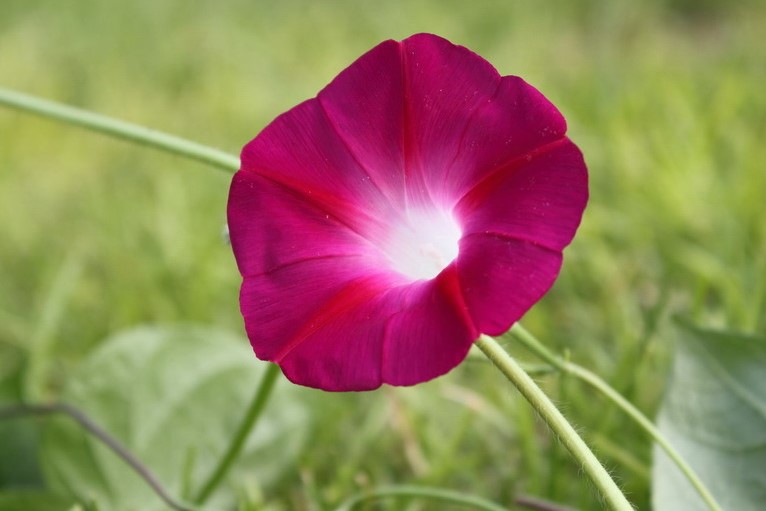
 Name: Morning Glory
Name: Morning Glory Family: Convolvulaceae
Family: Convolvulaceae Origins: Tropical and subtropical regions worldwide
Origins: Tropical and subtropical regions worldwide Humidity: Prefers high humidity levels but can tolerate moderate humidity.
Humidity: Prefers high humidity levels but can tolerate moderate humidity. Location: Full sun to partial shade.
Location: Full sun to partial shade. Soil: Well-drained, fertile soil with a neutral to slightly acidic pH.
Soil: Well-drained, fertile soil with a neutral to slightly acidic pH. Pests and diseases: Common pests include aphids, whiteflies, and spider mites. Common diseases include fungal diseases, leaf spot, and mosaic viruses.
Pests and diseases: Common pests include aphids, whiteflies, and spider mites. Common diseases include fungal diseases, leaf spot, and mosaic viruses. Care: Water regularly, especially during hot weather. Fertilize every 2-3 weeks with a balanced fertilizer. Deadhead spent flowers to encourage reblooming. Provide a trellis or support for climbing varieties.
Care: Water regularly, especially during hot weather. Fertilize every 2-3 weeks with a balanced fertilizer. Deadhead spent flowers to encourage reblooming. Provide a trellis or support for climbing varieties. Height of growth: Morning glories can grow anywhere from 3 feet to 20 feet tall, depending on the variety.
Height of growth: Morning glories can grow anywhere from 3 feet to 20 feet tall, depending on the variety. Planting in the soil: Plant morning glories outdoors after the last frost date. Space plants 6-12 inches apart, depending on the variety. Water deeply after planting.
Planting in the soil: Plant morning glories outdoors after the last frost date. Space plants 6-12 inches apart, depending on the variety. Water deeply after planting. Blooming: Morning glories typically bloom from early summer to late fall.
Blooming: Morning glories typically bloom from early summer to late fall.Morning Glory (Ipomoea) is a stunning, fast-growing annual or perennial known for its vibrant, trumpet-shaped flowers. With over a thousand species, it’s a versatile and popular choice among gardeners.
Content:
Morning Glory’s Botanical Beauty
The genus Ipomoea, part of the Convolvulaceae family, showcases a wide spectrum of colors, including purples, blues, pinks, and whites. Its distinctive flowers unfurl in the morning sunlight, giving the plant its poetic name.
Selecting the Right Morning Glory Variety
Diverse Morning Glory Species
- Ipomoea tricolor: Known for its large, blue flowers and heart-shaped leaves.
- Ipomoea purpurea: Features striking purple blooms and is a popular choice for trellises.
- Ipomoea nil: A classic choice with blue flowers and an ideal candidate for containers.
Climbing or Bush Morning Glories
Choose between climbing varieties, perfect for vertical spaces and trellises, or bush varieties for ground cover and hanging baskets. Consider your garden layout and available space.
Planting Morning Glory: A Step-by-Step Guide
Optimal Planting Time
Morning Glory thrives in warm climates. Plant seeds outdoors after the last frost, as they prefer temperatures above 50°F (10°C).
Soil Preparation
- Well-Draining Soil: Morning Glory prefers moderately fertile, well-draining soil.
- pH Level: Maintain a slightly acidic to neutral soil pH for optimal growth.
Proper Planting Technique
- Seed Soaking: Soak seeds in water overnight to aid germination.
- Planting Depth: Sow seeds ½ inch deep in the soil.
- Spacing: Provide 6-12 inches of space between plants or follow specific variety recommendations.
Nurturing Morning Glory: Care Tips
Watering
- Consistent Moisture: Keep the soil consistently moist but not waterlogged.
- Morning Watering: Water in the morning to prevent fungal diseases.
Sunshine Requirements
Morning Glories thrive in full sun. Ensure they receive at least 6 hours of direct sunlight daily for robust growth and prolific flowering.
Support for Climbing Varieties
Install trellises or other supports for climbing varieties to encourage upward growth and showcase the flowers.
Mulching
Apply a layer of organic mulch to retain moisture, suppress weeds, and regulate soil temperature.
Dealing with Pests and Diseases
Common Pests
Watch for pests like aphids and spider mites. Use insecticidal soap or neem oil for organic control.
Fungal Diseases
Proper spacing, morning watering, and well-draining soil help prevent fungal diseases like powdery mildew.
Blooming Beauty: Morning Glory Flowers
Extended Blooming Period
Morning Glories bloom profusely from early summer to fall. Deadhead spent flowers to promote continuous blooming.
Collecting Morning Glory Seeds
Allow some flowers to go to seed. Collect seeds for future planting, ensuring genetic diversity in your garden.
Frequently Asked Questions (FAQ)
Q1: Are Morning Glories invasive?
Morning Glories can be aggressive in some regions. Regular monitoring and control measures can help prevent them from becoming invasive.
Q2: Can Morning Glories be grown in containers?
Yes, select compact or bush varieties for container gardening. Ensure adequate support for climbing varieties in containers.
Q3: How do I prevent Morning Glory from taking over my garden?
Regular pruning and monitoring can prevent Morning Glory from becoming overly aggressive. Consider planting them in controlled spaces.
Q4: Are Morning Glories toxic to pets?
Yes, Morning Glory seeds contain compounds that can be toxic if ingested. Keep pets away from the plant, especially the seeds.
Q5: Do Morning Glories attract pollinators?
Morning Glories attract bees and butterflies with their vibrant, open flowers. They contribute to pollinator-friendly gardens.

